An Integrated Sensitivity and Uncertainty Quantification of Fragility Functions in RC Frames
Abstract
1. Introduction
1.1. Literature Review
1.2. Research Gap and Contributions
2. Underpinning Theory
2.1. Reliability-Based Analysis
2.1.1. FOSM
2.1.2. LHS
- Convert the initially generated matrix to data in standard normal space using the probability preserving equation [5]:
- Convert the desired correlation matrix to a correlation matrix that is compatible with a space similar than the standard normal space, except that the correlation matrix is not the identity matrix per the NATAF equation:
- Impose the converted correlation matrix on the secondary matrix generated in Step 1 by Cholesky decomposition [45] of the correlation matrix obtained in Step 2:
- In the final step, the desired dataset is computed, again using the probability preserving equation:
2.2. Collapse Fragility Functions
3. Procedure of Seismic Reliability Analysis
4. Case Study
4.1. Geometry and Dimensions
4.2. Constitutive Models and Random Variables
- COV = 0.5 for RV1: , and RV2: (: cyclic deterioration capacity)
- COV = 0.1 for RV3: , and RV4: (: ratio of capping to yield moment)
- COV = 0.6 for RV5: , RV6: , RV7: , and RV8: (: plastic rotation, : post-plastic rotation)
- All observations are limited to the two SMRF RC frames (four-story and eight-story) and similar frames designed according to modern design criteria.
- The epistemic uncertainty originates from four RVs, all concerning moment–rotation constitutive modeling of beams and columns, as illustrated in Figure 3a.
- There are separate assumed RVs for beam and column elements.
- The probabilistic specifications (e.g., distributional model, mean, STD, and correlation matrix) are all according to those mentioned in Section 4.2.
- All the primary results are based on a full correlation assumption among RVs. The results of fully uncorrelated models are presented in Section 5.14.
- The structural seismic responses are further modified according to the spectral shape considerations, as discussed in Section 5.1.
5. Results and Discussion
5.1. Direct IDA and Spectral Shape-Based Modifications
5.2. Direct IDA with LHS
5.3. Direct IDA with FOSM
5.4. Comparison of IDA-Based FOSM and LHS Techniques
5.5. SPO2IDA with LHS
5.6. SPO2IDA with FOSM
5.7. Limit States and Sensitivity
5.8. Uncertainty in Fragility Functions: Fitting and Randomness
5.9. Uncertainty in Fragility Functions: Models
5.10. -Dependent Median and Dispersion
- The median curves start diverging at approximately = 0.04 and 0.02 for four-story and eight-story frames, respectively.
- Comparing direct IDA methods, in both frames the RTR-only model (as well as the FOSM-based method) yields a higher median than the LHS-based one.
- Comparing SPO2IDA methods, in general, they are similar to the direct IDA method; however, for a small range of (i.e., 0.03–0.04), the LHS-based method has a slightly higher median.
- Comparing FOSM-based (or RTR only) methods, in the four-story frame SPO2IDA leads to a higher median, while in the eight-story one it is vice versa.
- Comparing LHS-based methods leads to similar conclusions as for the FOSM-based (or RTR only) method.
- Overall, the FOSM-based method does not affect the median, and the LHS-based method reduces the median (i.e., the inclusion of modeling uncertainty reduces the median of fragility functions).
- The direct IDA and SPO2IDA methods have two different trends at the lower values, in contrast with median response.
- Comparing direct IDA methods, both the LHS-based and FOSM-based approaches increase the value compared to the RTR-only method. This augmentation in dispersion is consistent with involving additional modeling uncertainties in the problem.
- Comparing SPO2IDA methods, the inclusion of modeling uncertainties increases the composite dispersion; however, the impact of FOSM is much greate than the LHS-based approach.
- Comparing FOSM-based methods, this method always leads to higher compared to the LHS-based approach and RTR-only model.
- Comparing LHS-based methods, the LHS-based values for direct IDA are higher than the SPO2IDA method in the four-story frame, and the trend is vice versa in the eight-story frame after of 0.04.
- Overall, the combination of these six cases yields a relatively large uncertainty in the value. This uncertainty, which increases with , is about 0.35 to 0.65 in both frames.
5.11. Fragility Surfaces
- The reliability-based failure probability can be simplified to .
- For the IDA based method, is 63% (IDA only), 78% (LHS), and 77% (FOSM).
- For the SPO2IDA based method, is 60% (IDA only), 71% (LHS), and 72% (FOSM).
- Again, the inclusion of epistemic uncertainty increases failure by about 15% and 10% in the IDA-based and SPO2IDA-based methods, respectively.
- Depending on the type of analysis and uncertainty propagation, failure may vary from 71% to 78%.
5.12. Direct IDA Based on Alternative IMs
- Spectral values at the fundamental period. IM: , IM: , IM: .
- Peak value in the time domain. IM: PGA, IM: PGV, IM: PGD.
- Spectral intensity values. IM: ASI, IM: VSI, IM: DSI.
- Root mean square values. IM: , IM: , IM: .
- Others. IM: SED, IM: CAV.
- Higher-order spectral values. IM: , IM:
5.13. Sensitivity of Fragility Curves to Alternative IMs
- RTR + LHS (four-story): = 0.47, = 0.39, = 0.35, SED = 0.86 (worst IM).
- RTR + LHS (eight-story): = 0.38, = 0.29, = 0.24, SED = 0.74 (worst IM).
- RTR + FOSM (four-story): = 0.39, = 0.32, = 0.29, = 0.71 (worst IM).
- RTR + FOSM (eight-story): = 0.34, = 0.26, = 0.22, PGA & ASI = 0.66 (worst IMs), (, , and SED are very close to the worst IMs)
- and are the two most optimal IMs. This means that incorporating higher modes and their effective masses highly reduces the dispersion.
- SED is the worst IM for the four-story frame, while for the eight-story frame there is no unique worst IM parameter.
5.14. Impact of Within-Element and Between-Element Variability
- The impact of variability on IDA and SPO2IDA medians begins at of 0.045 and 0.03, respectively, in the four-story frame. The corresponding values for the eight-story frame are 0.035 and 0.02, respectively.
- The uncorrelated assumption causes the IDA and SPO2IDA medians to decrease after the above-mentioned values are reached compared to the correlated models.
- The variability begins to affect the dispersion of IDA curves at values of 0.02 and 0.035 for the four-story and eight-story frames, respectively.
- The uncorrelated assumption causes the IDA dispersion to decrease after the above-mentioned values. However, the uncorrelation assumption does not significantly affect the SPO2IDA dispersion.
- In general, correlation does not have a significant efficacy on lower limit states; conversely, it decreases the median collapse capacity and dispersion values at higher limit states. These findings are aligned with the previously reported literature review.
6. Concluding Remarks
- The IM capacity point ratios fall in a wide range of 0.5 to 5.5 according to the LHS-based results for the two studied frames. This indicates that an impact of a “model-record” (structural model and ground motion record) combination is structure-dependent.
- The uncertainties associated with fragility curve fitting methods are negligible for the frames considered in this study.
- The uncertainties in the derivation of fragility functions can be quantified using the concept of robust fragility curves with a prescribed confidence interval while accounting for the joint probability distribution of the fragility model parameters.
- Both FOSM-based and LHS-based modeling uncertainties result in increasing the dispersion of the fragility curve as compared to RTR only.
- In comparison with IDA, the SPO2IDA method overestimates the capacity curve of the four-story frame, while it underestimates the dispersion of the eight-story frame. At higher LSs, the dispersion of SPO2IDA is lower than that of IDA for the four-story frame, whereas the opposite trend is observed for the eight-story frame. In addition, the median fragility curve for SPO2IDA is higher than that of the direct IDA in the four-story frame, while the trend is vice versa in the case of the eight-story frame.
- The impact of modeling uncertainties in terms of median begins to diverge at 0.04 and 0.02 values for the four-story and eight-story frames, respectively. The dispersion varies between 0.35–0.65 at high LS for all combinations considered for both frames.
- The development of an “uncertain fragility region” to account for different combinations of reliability and analysis methods indicates that the uncertain fragility region becomes thicker and rotates more at higher seismic performance levels.
- The probability of exceedance of a particular combination of for different analysis and reliability methods is presented in terms of fragility surfaces. The uncertainties in these fragility surfaces are then quantified by taking their mean and STD.
- Sixteen IM parameters are investigated by developing the corresponding IDA curves, which reveal various curves with distinct forms.
- The fragility curves derived based on sixteen IMs and for RTR with LHS/FOSM are diverse. Nonetheless, good consistency is observed between the two reliability approaches in terms of logarithmic STD and mean for different IM parameters.
- The IMs related to the higher-order spectral values yield the most optimal fragility curves among the various IMs considered in this paper. This indicates a remarkable decrease in dispersion when accounting for the higher modes and their effective masses.
- In general, the spatial correlation modeling assumption does not have a significant trace on lower limit states; conversely, the uncorrelated random variables assumption decreases the median collapse capacity and dispersion values at higher limit states.
Author Contributions
Funding
Data Availability Statement
Conflicts of Interest
Appendix A. Details of Case Study Frames
| Elem | h [cm] | b [cm] | s [cm] | [rad] | [rad] | |||||
|---|---|---|---|---|---|---|---|---|---|---|
| B1 | 60 | 55 | 0.0043 | 0.0083 | 0.0033 | 12.5 | 0.0414 | 0.1 | 1.21 | 174.15 |
| B2 | 60 | 55 | 0.0043 | 0.0083 | 0.0033 | 12.5 | 0.0414 | 0.1 | 1.21 | 174.15 |
| B3 | 60 | 55 | 0.0043 | 0.0083 | 0.0033 | 12.5 | 0.0414 | 0.1 | 1.21 | 174.15 |
| B4 | 60 | 55 | 0.0037 | 0.0075 | 0.0033 | 12.5 | 0.0401 | 0.1 | 1.21 | 174.15 |
| B5 | 60 | 55 | 0.0037 | 0.0075 | 0.0033 | 12.5 | 0.0401 | 0.1 | 1.21 | 174.15 |
| B6 | 60 | 55 | 0.0037 | 0.0075 | 0.0033 | 12.5 | 0.0401 | 0.1 | 1.21 | 174.15 |
| B7 | 60 | 55 | 0.0037 | 0.0075 | 0.0033 | 12.5 | 0.0394 | 0.1 | 1.21 | 174.15 |
| B8 | 60 | 55 | 0.0032 | 0.006 | 0.0033 | 12.5 | 0.0394 | 0.1 | 1.21 | 174.15 |
| B9 | 60 | 55 | 0.0032 | 0.006 | 0.0033 | 12.5 | 0.0394 | 0.1 | 1.21 | 174.15 |
| B10 | 60 | 55 | 0.0032 | 0.0045 | 0.0033 | 12.5 | 0.0403 | 0.1 | 1.21 | 174.15 |
| B11 | 60 | 55 | 0.0032 | 0.0045 | 0.0033 | 12.5 | 0.0403 | 0.1 | 1.21 | 174.15 |
| B12 | 60 | 55 | 0.0032 | 0.0045 | 0.0033 | 12.5 | 0.0403 | 0.1 | 1.21 | 174.15 |
| Elem | h [cm] | b [cm] | s [cm] | [rad] | [rad] | |||||
|---|---|---|---|---|---|---|---|---|---|---|
| C1 | 55 | 55 | 0.06 | 0.013 | 0.007 | 12.5 | 0.064 | 0.1 | 1.202 | 152.63 |
| C2 | 55 | 55 | 0.13 | 0.0163 | 0.007 | 12.5 | 0.0579 | 0.1 | 1.192 | 139.26 |
| C3 | 55 | 55 | 0.13 | 0.0163 | 0.007 | 12.5 | 0.0579 | 0.1 | 1.192 | 139.26 |
| C4 | 55 | 55 | 0.06 | 0.013 | 0.007 | 12.5 | 0.064 | 0.1 | 1.202 | 152.63 |
| C5 | 55 | 55 | 0.05 | 0.013 | 0.007 | 12.5 | 0.0652 | 0.1 | 1.203 | 154.64 |
| C6 | 55 | 55 | 0.1 | 0.0163 | 0.007 | 12.5 | 0.0611 | 0.1 | 1.196 | 144.84 |
| C7 | 55 | 55 | 0.1 | 0.0163 | 0.007 | 12.5 | 0.0611 | 0.1 | 1.196 | 144.84 |
| C8 | 55 | 55 | 0.05 | 0.013 | 0.007 | 12.5 | 0.0652 | 0.1 | 1.203 | 154.64 |
| C9 | 55 | 55 | 0.03 | 0.0113 | 0.007 | 12.5 | 0.0667 | 0.1 | 1.206 | 158.74 |
| C10 | 55 | 55 | 0.06 | 0.0145 | 0.007 | 12.5 | 0.0648 | 0.1 | 1.202 | 152.63 |
| C11 | 55 | 55 | 0.06 | 0.0145 | 0.007 | 12.5 | 0.0648 | 0.1 | 1.202 | 152.63 |
| C12 | 55 | 55 | 0.03 | 0.0113 | 0.007 | 12.5 | 0.0667 | 0.1 | 1.206 | 158.74 |
| C13 | 55 | 55 | 0.02 | 0.0113 | 0.007 | 12.5 | 0.0679 | 0.1 | 1.207 | 160.84 |
| C14 | 55 | 55 | 0.03 | 0.0145 | 0.007 | 12.5 | 0.0685 | 0.1 | 1.206 | 158.75 |
| C15 | 55 | 55 | 0.03 | 0.0145 | 0.007 | 12.5 | 0.0685 | 0.1 | 1.206 | 158.75 |
| C16 | 55 | 55 | 0.02 | 0.0113 | 0.007 | 12.5 | 0.0679 | 0.1 | 1.207 | 160.84 |
| Elem | h [cm] | b [cm] | s [cm] | [rad] | [rad] | |||||
|---|---|---|---|---|---|---|---|---|---|---|
| B1 | 55 | 55 | 0.0055 | 0.0108 | 0.0037 | 11.5 | 0.047 | 0.1 | 1.21 | 174.99 |
| B2 | 55 | 55 | 0.0055 | 0.0108 | 0.0037 | 11.5 | 0.047 | 0.1 | 1.21 | 174.99 |
| B3 | 55 | 55 | 0.0055 | 0.0108 | 0.0037 | 11.5 | 0.047 | 0.1 | 1.21 | 174.99 |
| B4 | 55 | 55 | 0.0055 | 0.011 | 0.0037 | 11.5 | 0.047 | 0.1 | 1.21 | 174.99 |
| B5 | 55 | 55 | 0.0055 | 0.011 | 0.0037 | 11.5 | 0.047 | 0.1 | 1.21 | 174.99 |
| B6 | 55 | 55 | 0.0055 | 0.011 | 0.0037 | 11.5 | 0.047 | 0.1 | 1.21 | 174.99 |
| B7 | 55 | 55 | 0.0055 | 0.011 | 0.0037 | 11.5 | 0.047 | 0.1 | 1.21 | 174.99 |
| B8 | 55 | 55 | 0.0055 | 0.011 | 0.0037 | 11.5 | 0.047 | 0.1 | 1.21 | 174.99 |
| B9 | 55 | 55 | 0.0055 | 0.011 | 0.0037 | 11.5 | 0.047 | 0.1 | 1.21 | 174.99 |
| B10 | 55 | 55 | 0.0055 | 0.011 | 0.0037 | 11.5 | 0.047 | 0.1 | 1.21 | 174.99 |
| B11 | 55 | 55 | 0.0055 | 0.011 | 0.0037 | 11.5 | 0.047 | 0.1 | 1.21 | 174.99 |
| B12 | 55 | 55 | 0.0055 | 0.011 | 0.0037 | 11.5 | 0.047 | 0.1 | 1.21 | 174.99 |
| B13 | 45 | 55 | 0.0065 | 0.0133 | 0.0046 | 9 | 0.0565 | 0.1 | 1.21 | 174.99 |
| B14 | 45 | 55 | 0.0065 | 0.0133 | 0.0046 | 9 | 0.0565 | 0.1 | 1.21 | 174.99 |
| B15 | 45 | 55 | 0.0065 | 0.0133 | 0.0046 | 9 | 0.0565 | 0.1 | 1.21 | 174.99 |
| B16 | 45 | 55 | 0.0065 | 0.0133 | 0.0046 | 9 | 0.0565 | 0.1 | 1.21 | 174.99 |
| B17 | 45 | 55 | 0.0065 | 0.0133 | 0.0046 | 9 | 0.0565 | 0.1 | 1.21 | 174.99 |
| B18 | 45 | 55 | 0.0065 | 0.0133 | 0.0046 | 9 | 0.0565 | 0.1 | 1.21 | 174.99 |
| B19 | 45 | 55 | 0.006 | 0.0125 | 0.0046 | 9 | 0.0554 | 0.1 | 1.21 | 174.99 |
| B20 | 45 | 55 | 0.006 | 0.0125 | 0.0046 | 9 | 0.0554 | 0.1 | 1.21 | 174.99 |
| B21 | 45 | 55 | 0.006 | 0.0125 | 0.0046 | 9 | 0.0554 | 0.1 | 1.21 | 174.99 |
| B22 | 45 | 55 | 0.0065 | 0.0085 | 0.0046 | 9 | 0.0553 | 0.1 | 1.21 | 174.99 |
| B23 | 45 | 55 | 0.0065 | 0.0085 | 0.0046 | 9 | 0.0553 | 0.1 | 1.21 | 174.99 |
| B24 | 45 | 55 | 0.0065 | 0.0085 | 0.0046 | 9 | 0.0553 | 0.1 | 1.21 | 174.99 |
| Elem | h [cm] | b [cm] | s [cm] | [rad] | [rad] | |||||
|---|---|---|---|---|---|---|---|---|---|---|
| C1 | 55 | 55 | 0.11 | 0.0115 | 0.0084 | 10 | 0.0631 | 0.1 | 1.187 | 160.59 |
| C2 | 55 | 55 | 0.21 | 0.0105 | 0.0084 | 10 | 0.0503 | 0.1 | 1.173 | 140.88 |
| C3 | 55 | 55 | 0.21 | 0.0105 | 0.0084 | 10 | 0.0503 | 0.1 | 1.173 | 140.88 |
| C4 | 55 | 55 | 0.11 | 0.0115 | 0.0084 | 10 | 0.0631 | 0.1 | 1.187 | 160.59 |
| C5 | 55 | 55 | 0.09 | 0.0115 | 0.0084 | 10 | 0.0655 | 0.1 | 1.19 | 164.85 |
| C6 | 55 | 55 | 0.19 | 0.0105 | 0.0084 | 10 | 0.0521 | 0.1 | 1.176 | 144.62 |
| C7 | 55 | 55 | 0.19 | 0.0105 | 0.0084 | 10 | 0.0521 | 0.1 | 1.176 | 144.62 |
| C8 | 55 | 55 | 0.09 | 0.0115 | 0.0084 | 10 | 0.0655 | 0.1 | 1.19 | 164.85 |
| C9 | 55 | 55 | 0.08 | 0.012 | 0.0084 | 10 | 0.0675 | 0.1 | 1.191 | 167.02 |
| C10 | 55 | 55 | 0.16 | 0.014 | 0.0084 | 10 | 0.0592 | 0.1 | 1.18 | 150.41 |
| C11 | 55 | 55 | 0.16 | 0.014 | 0.0084 | 10 | 0.0592 | 0.1 | 1.18 | 150.41 |
| C12 | 55 | 55 | 0.08 | 0.012 | 0.0084 | 10 | 0.0675 | 0.1 | 1.191 | 167.02 |
| C13 | 55 | 55 | 0.07 | 0.012 | 0.0084 | 10 | 0.0687 | 0.1 | 1.192 | 169.22 |
| C14 | 55 | 55 | 0.13 | 0.014 | 0.0084 | 10 | 0.0626 | 0.1 | 1.184 | 156.43 |
| C15 | 55 | 55 | 0.13 | 0.014 | 0.0084 | 10 | 0.0626 | 0.1 | 1.184 | 156.43 |
| C16 | 55 | 55 | 0.07 | 0.012 | 0.0084 | 10 | 0.0687 | 0.1 | 1.192 | 169.22 |
| C17 | 55 | 55 | 0.05 | 0.012 | 0.0084 | 10 | 0.0713 | 0.1 | 1.195 | 173.71 |
| C18 | 55 | 55 | 0.11 | 0.0135 | 0.0084 | 10 | 0.0647 | 0.1 | 1.187 | 160.59 |
| C19 | 55 | 55 | 0.11 | 0.0135 | 0.0084 | 10 | 0.0647 | 0.1 | 1.187 | 160.59 |
| C20 | 55 | 55 | 0.05 | 0.012 | 0.0084 | 10 | 0.0713 | 0.1 | 1.195 | 173.71 |
| C21 | 55 | 55 | 0.04 | 0.012 | 0.0084 | 10 | 0.0726 | 0.1 | 1.196 | 176 |
| C22 | 55 | 55 | 0.08 | 0.0135 | 0.0084 | 10 | 0.0683 | 0.1 | 1.191 | 167.02 |
| C23 | 55 | 55 | 0.08 | 0.0135 | 0.0084 | 10 | 0.0683 | 0.1 | 1.191 | 167.02 |
| C24 | 55 | 55 | 0.04 | 0.012 | 0.0084 | 10 | 0.0726 | 0.1 | 1.196 | 176 |
| C25 | 55 | 55 | 0.03 | 0.012 | 0.0084 | 10 | 0.074 | 0.1 | 1.198 | 178.32 |
| C26 | 55 | 55 | 0.05 | 0.014 | 0.0084 | 10 | 0.0725 | 0.1 | 1.195 | 173.71 |
| C27 | 55 | 55 | 0.05 | 0.014 | 0.0084 | 10 | 0.0725 | 0.1 | 1.195 | 173.71 |
| C28 | 55 | 55 | 0.03 | 0.012 | 0.0084 | 10 | 0.074 | 0.1 | 1.198 | 178.32 |
| C29 | 55 | 55 | 0.01 | 0.012 | 0.0084 | 10 | 0.0767 | 0.1 | 1.201 | 183.05 |
| C30 | 55 | 55 | 0.03 | 0.014 | 0.0084 | 10 | 0.0752 | 0.1 | 1.198 | 178.32 |
| C31 | 55 | 55 | 0.03 | 0.014 | 0.0084 | 10 | 0.0752 | 0.1 | 1.198 | 178.32 |
| C32 | 55 | 55 | 0.01 | 0.012 | 0.0084 | 10 | 0.0767 | 0.1 | 1.201 | 183.05 |
References
- O’Hagan, A.; Oakley, J.E. Probability is perfect, but we can’t elicit it perfectly. Reliab. Eng. Syst. Saf. 2004, 85, 239–248. [Google Scholar] [CrossRef]
- Aslani, H.; Miranda, E. Probabilistic Earthquake Loss Estimation and Loss Disaggregation in Buildings. Ph.D. Thesis, Stanford University, Stanford, CA, USA, 2005. [Google Scholar]
- Ibarra, L.F.; Krawinkler, H. Global Collapse of Frame Structures under Seismic Excitations; Pacific Earthquake Engineering Research Center: Berkeley, CA, USA, 2005. [Google Scholar]
- Porter, K. An overview of PEER’s performance-based earthquake engineering methodology. In Proceedings of the 9th International Conference on Applications of Statistics and Probability in Civil Engineering (ICASP9), Francisco, CA, USA, 6–9 July 2003. [Google Scholar]
- Vamvatsikos, D.; Cornell, C. Incremental dynamic analysis. Earthq. Eng. Struct. Dyn. 2002, 31, 491–514. [Google Scholar] [CrossRef]
- Jalayer, F. Direct Probabilistic Seismic Analysis: Implementing Non-Linear Dynamic Assessments. Ph.D. Thesis, Stanford University, Stanford, CA, USA, 2003. [Google Scholar]
- Segura, C.; Sattar, S.; Hariri-Ardebili, M. Uncertainty in the Seismic Response of an RC Bridge Column due to Material Variability. ACI Struct. J. 2022, 119, 141–152. [Google Scholar]
- Ellingwood, B. Development of a Probability Based Load Criterion for American National Standard A58: Building Code Requirements for Minimum Design Loads in Buildings and Other Structures; US Department of Commerce, National Bureau of Standards: Gaithersburg, MD, USA, 1980; Volume 13.
- Ibarra, L.F.; Medina, R.A.; Krawinkler, H. Hysteretic models that incorporate strength and stiffness deterioration. Earthq. Eng. Struct. Dyn. 2005, 34, 1489–1511. [Google Scholar] [CrossRef]
- Panagiotakos, T.B.; Fardis, M.N. Deformations of reinforced concrete members at yielding and ultimate. Struct. J. 2001, 98, 135–148. [Google Scholar]
- Haselton, C.B.; Liel, A.B.; Taylor-Lange, S.C.; Deierlein, G.G. Calibration of Model to Simulate Response of Reinforced Concrete Beam-Columns to Collapse. ACI Struct. J. 2016, 113, 1141–1152. [Google Scholar] [CrossRef]
- Lignos, D.G.; Zareian, F.; Krawinkler, H. Reliability of a 4-story steel moment-resisting frame against collapse due to seismic excitations. In Proceedings of the Structures Congress 2008: Crossing Borders, Vancouver, BC, Canada, 24–26 April 2008; pp. 1–10. [Google Scholar]
- Haselton, C.; Deierlein, G. Assessing Seismic Collapse Safety of Modern Reinforced Concrete Moment Frame Buildings, Report No. TR 156; Technical Report; John A. Blume Earthquake Engineering Center Department of Civil Engineering: Stanford, CA, USA, 2006. [Google Scholar]
- Khojastehfar, E.; Beheshti-Aval, S.B.; Zolfaghari, M.R.; Nasrollahzade, K. Collapse fragility curve development using Monte Carlo simulation and artificial neural network. Proc. Inst. Mech. Eng. Part O J. Risk Reliab. 2014, 228, 301–312. [Google Scholar] [CrossRef]
- Asgarian, B.; Ordoubadi, B. Effects of structural uncertainties on seismic performance of steel moment resisting frames. J. Constr. Steel Res. 2016, 120, 132–142. [Google Scholar] [CrossRef]
- Ricci, P.; Manfredi, V.; Noto, F.; Terrenzi, M.; Petrone, C.; Celano, F.; De Risi, M.T.; Camata, G.; Franchin, P.; Magliulo, G.; et al. Modeling and seismic response analysis of Italian code-conforming reinforced concrete buildings. J. Earthq. Eng. 2018, 22, 105–139. [Google Scholar] [CrossRef]
- Badalassi, M.; Braconi, A.; Cajot, L.G.; Caprili, S.; Degee, H.; Gündel, M.; Hjiaj, M.; Hoffmeister, B.; Karamanos, S.A.; Salvatore, W.; et al. Influence of variability of material mechanical properties on seismic performance of steel and steel–concrete composite structures. Bull. Earthq. Eng. 2017, 15, 1559–1607. [Google Scholar] [CrossRef]
- British Standards Institution. Eurocode 8. Design of Structures for Earthquake Resistance. Assessment and Retrofitting of Buildings; British Standards Institution: London, UK, 2005. [Google Scholar]
- Barbato, M.; Zona, A.; Conte, J.P. Probabilistic nonlinear response analysis of steel-concrete composite beams. J. Struct. Eng. 2014, 140, 04013034. [Google Scholar] [CrossRef]
- Vamvatsikos, D.; Fragiadakis, M. Incremental dynamic analysis for estimating seismic performance sensitivity and uncertainty. Earthq. Eng. Struct. Dyn. 2010, 39, 141–163. [Google Scholar] [CrossRef]
- Kazantzi, A.; Vamvatsikos, D.; Lignos, D. Seismic performance of a steel moment-resisting frame subject to strength and ductility uncertainty. Eng. Struct. 2014, 78, 69–77. [Google Scholar] [CrossRef]
- Zareian, F.; Krawinkler, H.; Ibarra, L.; Lignos, D. Basic concepts and performance measures in prediction of collapse of buildings under earthquake ground motions. Struct. Des. Tall Spec. Build. 2010, 19, 167–181. [Google Scholar] [CrossRef]
- Dolšek, M. Incremental dynamic analysis with consideration of modeling uncertainties. Earthq. Eng. Struct. Dyn. 2009, 38, 805–825. [Google Scholar] [CrossRef]
- Kwon, O.S.; Elnashai, A. The effect of material and ground motion uncertainty on the seismic vulnerability curves of RC structure. Eng. Struct. 2006, 28, 289–303. [Google Scholar] [CrossRef]
- Kennedy, R.; Cornell, C.; Campbell, R.; Kaplan, S.; Perla, H. Probabilistic seismic safety study of an existing nuclear power plant. Nucl. Eng. Des. 1980, 59, 315–338. [Google Scholar] [CrossRef]
- Shinozuka, M.; Feng, M.; Lee, J.; Naganuma, T. Statistical analysis of fragility curves. J. Eng. Mech. 2000, 126, 1224–1231. [Google Scholar] [CrossRef]
- Baker, J. Efficient analytical fragility function fitting using dynamic structural analysis. Earthq. Spectra 2015, 31, 579–599. [Google Scholar] [CrossRef]
- Lallemant, D.; Kiremidjian, A.; Burton, H. Statistical procedures for developing earthquake damage fragility curves. Earthq. Eng. Struct. Dyn. 2015, 44, 1373–1389. [Google Scholar] [CrossRef]
- Miano, A.; Jalayer, F.; Ebrahimian, H.; Prota, A. Cloud to IDA: Efficient fragility assessment with limited scaling. Earthq. Eng. Struct. Dyn. 2018, 47, 1124–1147. [Google Scholar] [CrossRef]
- Mai, C.; Konakli, K.; Sudret, B. Seismic fragility curves for structures using non-parametric representations. Front. Struct. Civ. Eng. 2017, 11, 169–186. [Google Scholar] [CrossRef]
- Iervolino, I. Assessing uncertainty in estimation of seismic response for PBEE. Earthq. Eng. Struct. Dyn. 2017, 46, 1711–1723. [Google Scholar] [CrossRef]
- Baraschino, R.; Baltzopoulos, G.; Iervolino, I. R2R-EU: Software for fragility fitting and evaluation of estimation uncertainty in seismic risk analysis. Soil Dyn. Earthq. Eng. 2020, 132, 106093. [Google Scholar] [CrossRef]
- Baltzopoulos, G.; Baraschino, R.; Iervolino, I. On the number of records for structural risk estimation in PBEE. Earthq. Eng. Struct. Dyn. 2019, 48, 489–506. [Google Scholar] [CrossRef]
- De Risi, R.; Goda, K.; Tesfamariam, S. Multi-dimensional damage measure for seismic reliability analysis. Struct. Saf. 2019, 78, 1–11. [Google Scholar] [CrossRef]
- Basone, F.; Cavaleri, L.; Di Trapani, F.; Muscolino, G. Incremental dynamic based fragility assessment of reinforced concrete structures: Stationary vs. non-stationary artificial ground motions. Soil Dyn. Earthq. Eng. 2017, 103, 105–117. [Google Scholar] [CrossRef]
- Lemaire, M. Structural Reliability; John Wiley & Sons: Hoboken, NJ, USA, 2013. [Google Scholar]
- Ditlevsen, O.; Madsen, H.O. Structural Reliability Methods; Wiley: New York, NY, USA, 1996; Volume 178. [Google Scholar]
- Stein, M. Large sample properties of simulations using Latin hypercube sampling. Technometrics 1987, 29, 143–151. [Google Scholar] [CrossRef]
- Celarec, D.; Dolšek, M. The impact of modelling uncertainties on the seismic performance assessment of reinforced concrete frame buildings. Eng. Struct. 2013, 52, 340–354. [Google Scholar] [CrossRef]
- Cornell, C.A.; Jalayer, F.; Hamburger, R.O.; Foutch, D.A. Probabilistic basis for 2000 SAC federal emergency management agency steel moment frame guidelines. J. Struct. Eng. 2002, 128, 526–533. [Google Scholar] [CrossRef]
- Liel, A.; Haselton, C.; Deierlein, G.; Baker, J. Incorporating modeling uncertainties in the assessment of seismic collapse risk of buildings. Struct. Saf. 2009, 31, 197–211. [Google Scholar] [CrossRef]
- Matlab, R. Statistics Toolbox Release; The MathWorks Inc.: Natick, MA, USA, 2019. [Google Scholar]
- Der Kiureghian, A.; Liu, P.L. Structural reliability under incomplete probability information. J. Eng. Mech. 1986, 112, 85–104. [Google Scholar] [CrossRef]
- Liu, P.L.; Der Kiureghian, A. Multivariate distribution models with prescribed marginals and covariances. Probabilistic Eng. Mech. 1986, 1, 105–112. [Google Scholar] [CrossRef]
- Horn, R.; Johnson, C. Matrix Analysis; Cambridge University Press: Cambridge, UK, 1985. [Google Scholar]
- Vamvatsikos, D.; Allin Cornell, C. Direct estimation of the seismic demand and capacity of oscillators with multi-linear static pushovers through IDA. Earthq. Eng. Struct. Dyn. 2006, 35, 1097–1117. [Google Scholar] [CrossRef]
- Fragiadakis, M.; Vamvatsikos, D. Fast performance uncertainty estimation via pushover and approximate IDA. Earthq. Eng. Struct. Dyn. 2010, 39, 683–703. [Google Scholar] [CrossRef]
- FEMA P695. Quantification of Building Seismic Performance Factors; Technical Report Prepared by Applied Technology Council for the Federal Emergency Management Agency; FEMA: Washington, DC, USA, 2009.
- Franchin, P.; Ragni, L.; Rota, M.; Zona, A. Modelling uncertainties of Italian code-conforming structures for the purpose of seismic response analysis. J. Earthq. Eng. 2018, 22, 1964–1989. [Google Scholar] [CrossRef]
- Lignos, D. Sidesway Collapse of Deteriorating Structural Systems under Seismic Excitations; Stanford University: Stanford, CA, USA, 2008. [Google Scholar]
- Mazzoni, S.; McKenna, F.; Scott, M.H.; Fenves, G. The Open System for Earthquake Engineering Simulation (OpenSEES) User Command-Language Manual; Technical Report; Pacific Earthquake Engineering Research Center, University of California: Berkeley, CA, USA, 2006. [Google Scholar]
- McKenna, F. OpenSees: A framework for earthquake engineering simulation. Comput. Sci. Eng. 2011, 13, 58–66. [Google Scholar] [CrossRef]
- Poul, M.K.; Zerva, A. Time-domain PML formulation for modeling viscoelastic waves with Rayleigh-type damping in an unbounded domain: Theory and application in ABAQUS. Finite Elem. Anal. Des. 2018, 152, 1–16. [Google Scholar] [CrossRef]
- Haselton, C.; Baker, J.; Liel, A.; Deierlein, G. Accounting for ground-motion spectral shape characteristics in structural collapse assessment through an adjustment for epsilon. Struct. Eng. 2011, 137, 332–344. [Google Scholar] [CrossRef]
- Baker, J.; Cornell, C. A vector-valued ground motion intensity measure consisting of spectral acceleration and epsilon. Earthq. Eng. Struct. Dyn. 2005, 34, 1193–1217. [Google Scholar] [CrossRef]
- Zareian, F. Simplified Performance-Based Earthquake Engineering. Ph.D. Thesis, Stanford University, Stanford, CA, USA, 2006. [Google Scholar]
- Abrahamson, N.; Silva, W.J. Empirical response spectral attenuation relations for shallow crustal earthquakes. Seismol. Res. Lett. 1997, 68, 94–127. [Google Scholar] [CrossRef]
- Hariri-Ardebili, M.A.; Pourkamali-Anaraki, F. Structural uncertainty quantification with partial information. Expert Syst. Appl. 2022, 198, 116736. [Google Scholar] [CrossRef]
- Hariri-Ardebili, M.; Saouma, V. Collapse Fragility Curves for Concrete Dams: Comprehensive Study. ASCE J. Struct. Eng. 2016, 142, 04016075. [Google Scholar] [CrossRef]
- Jalayer, F.; De Risi, R.; Manfredi, G. Bayesian Cloud Analysis: Efficient structural fragility assessment using linear regression. Bull. Earthq. Eng. 2015, 13, 1183–1203. [Google Scholar] [CrossRef]
- Hariri-Ardebili, M.; Saouma, V. Probabilistic seismic demand model and optimal intensity measure for concrete dams. Struct. Saf. 2016, 59, 67–85. [Google Scholar] [CrossRef]
- Jankovic, S.; Stojadinovic, B. Probabilistic performance-based seismic demand model for {R/C} frame buildings. In Proceedings of the 13th World Conferance on Earthquake Engineering, Vancouver, BC, Canada, 1–6 August 2004. [Google Scholar]
- Mackie, K.; Stojadinovic, B. Comparison of Incremental Dynamic, Cloud, and Stripe methods for computing probabilistic seismic demand models. In Proceedings of the 2005 Structures Congress and the 2005 Forensic Engineering Symposium, New York, NY, USA, 20–24 April 2005. [Google Scholar]
- Tothong, P.; Luco, N. Probabilistic seismic demand analysis using advanced ground motion intensity measures. Earthq. Eng. Struct. Dyn. 2007, 36, 1837–1860. [Google Scholar] [CrossRef]
- Tondini, N.; Stojadinovic, B. Probabilistic seismic demand model for curved reinforced concrete bridges. Bull. Earthq. Eng. 2012, 10, 1455–1479. [Google Scholar] [CrossRef]
- Hariri-Ardebili, M.; Pourkamali-Anaraki, F. Matrix completion for cost reduction in finite element simulations under hybrid uncertainties. Appl. Math. Model. 2019, 69, 164–180. [Google Scholar] [CrossRef]
- Vamvatsikos, D. Seismic performance uncertainty estimation via IDA with progressive accelerogram-wise latin hypercube sampling. J. Struct. Eng. 2014, 140, A4014015. [Google Scholar] [CrossRef]
- Gokkaya, B.; Baker, J.; Deierlein, G. Estimation and impacts of model parameter correlation for seismic performance assessment of reinforced concrete structures. Struct. Saf. 2017, 69, 68–78. [Google Scholar] [CrossRef]
- Idota, H.; Guan, L.; Yamazaki, K. Statistical correlation of steel members for system reliability analysis. In Proceedings of the 9th international conference on structural safety and reliability (ICOSSAR), Osaka, Japan, 13–17 September 2009. [Google Scholar]
- Liu, Z.; Atamturktur, S.; Juang, C.H. Reliability based multi-objective robust design optimization of steel moment resisting frame considering spatial variability of connection parameters. Eng. Struct. 2014, 76, 393–403. [Google Scholar] [CrossRef]
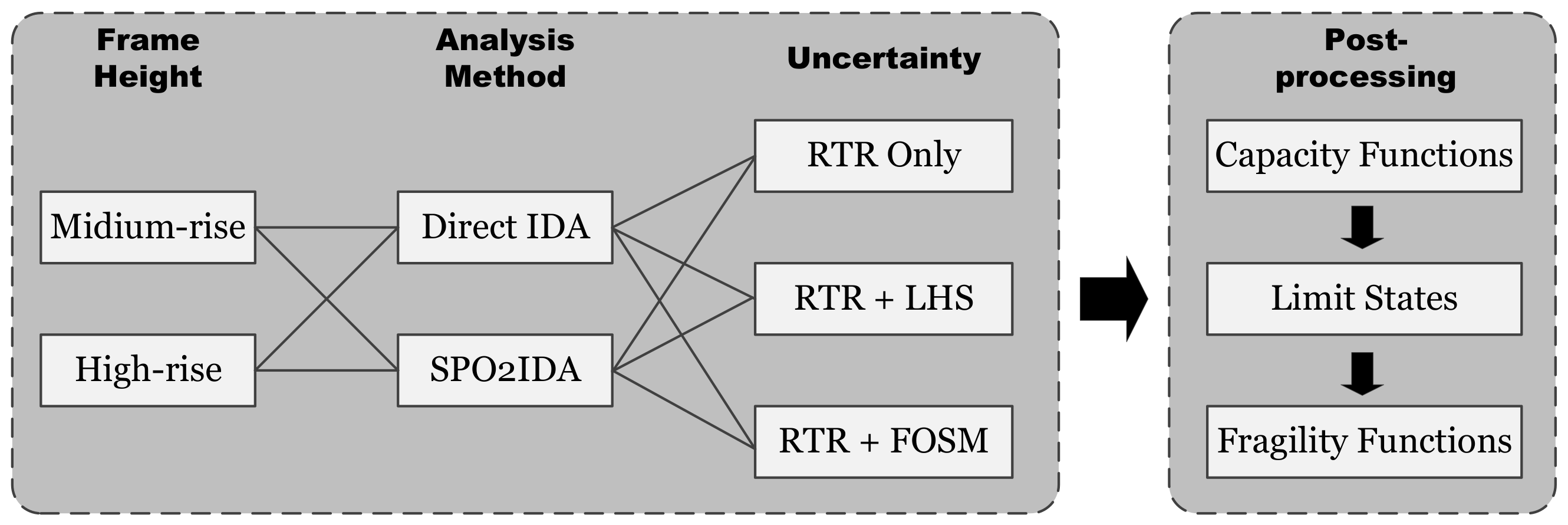
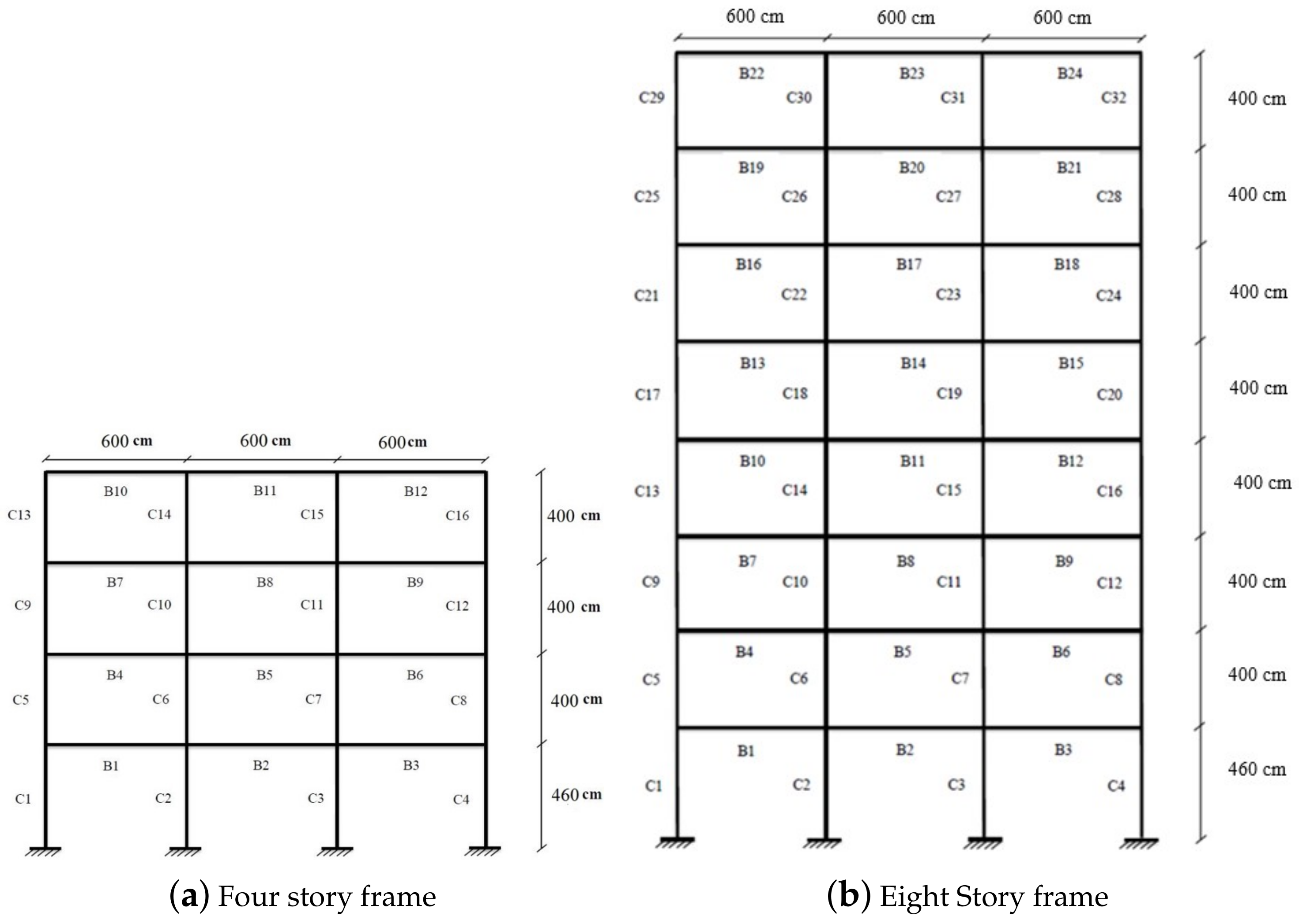
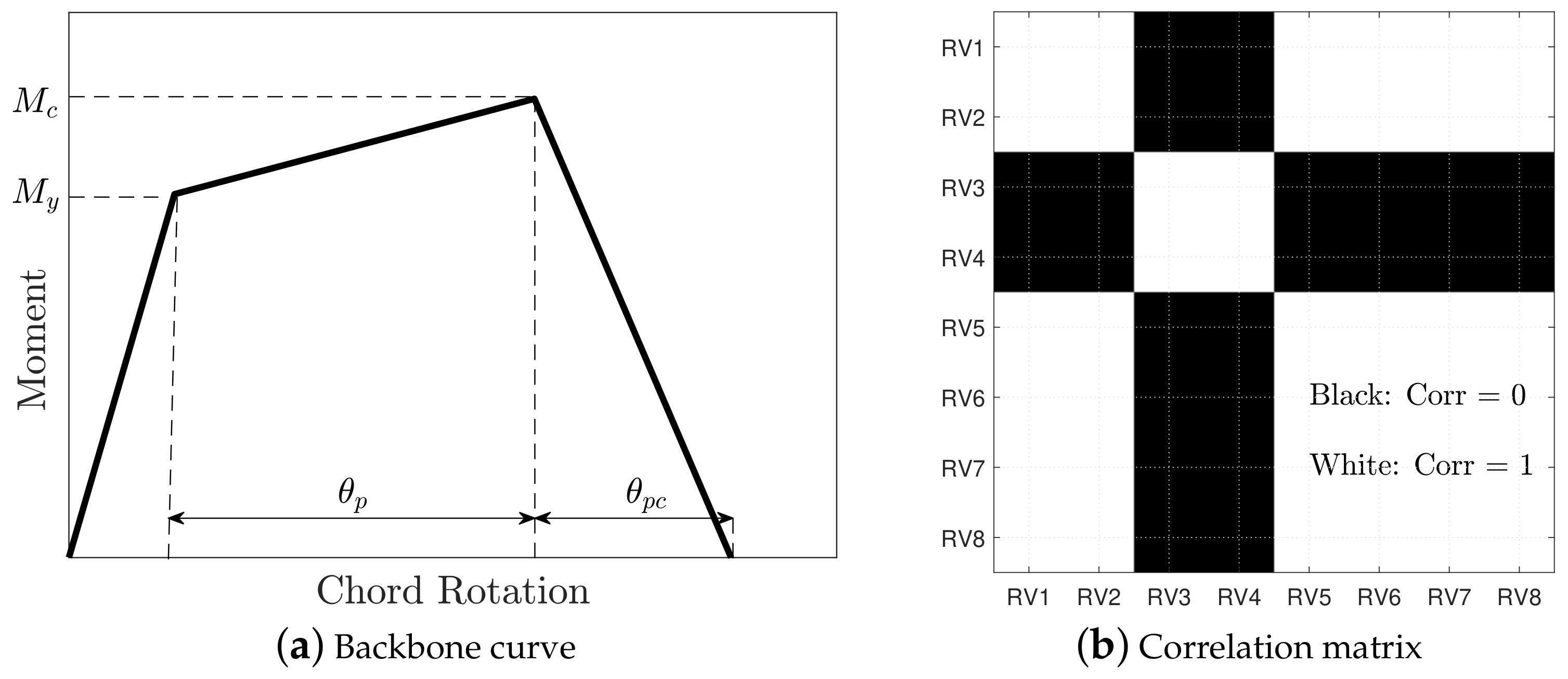
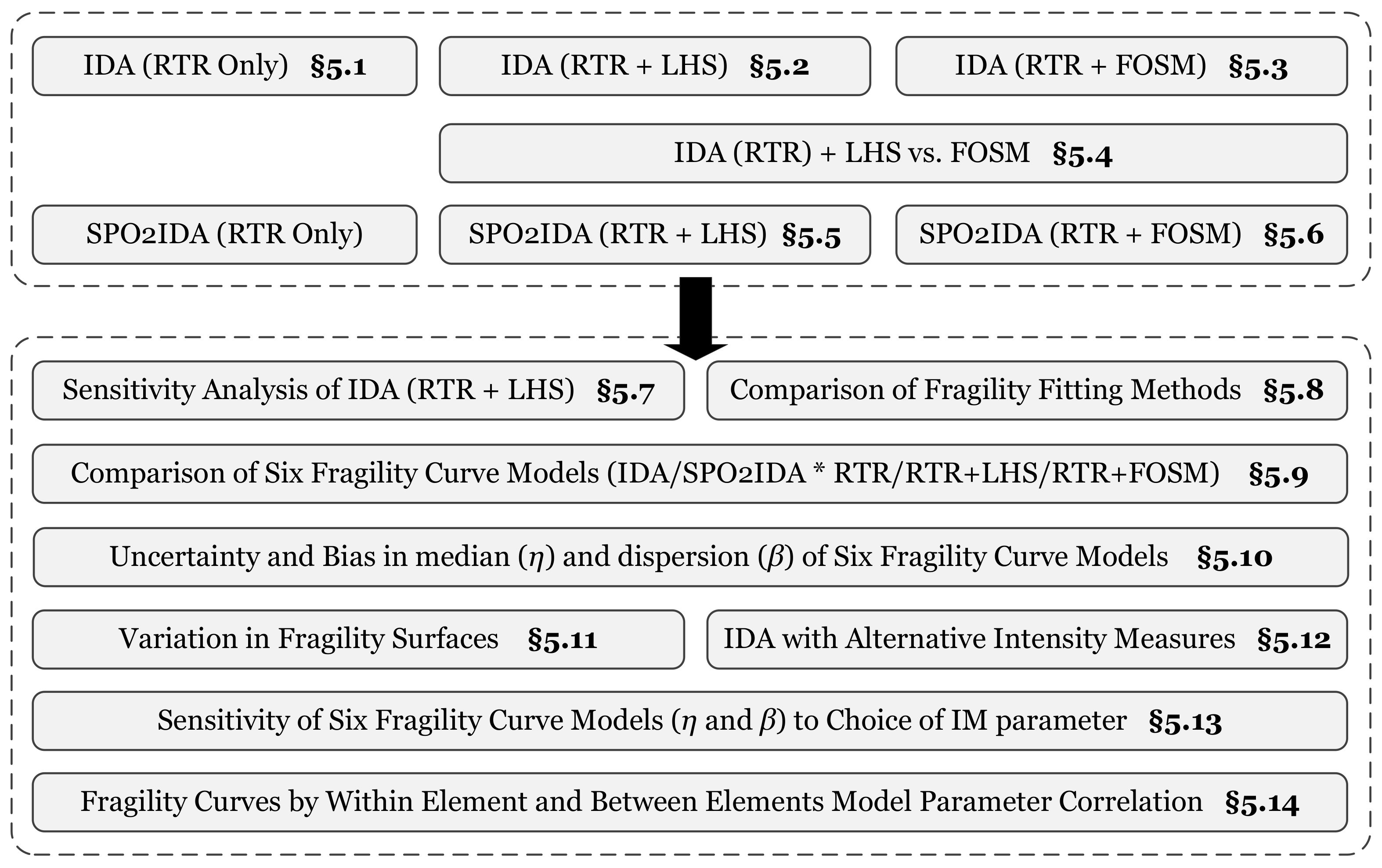



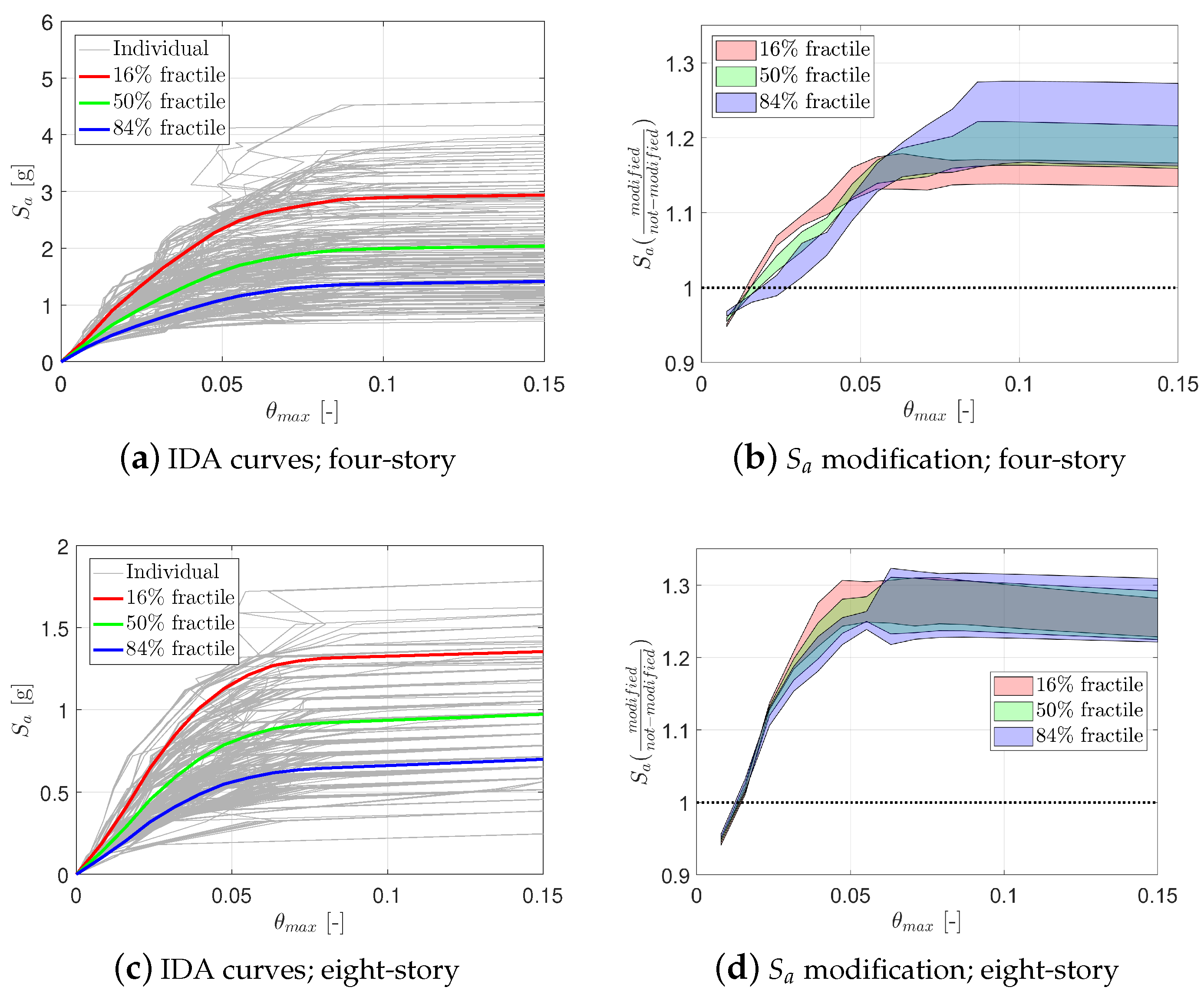
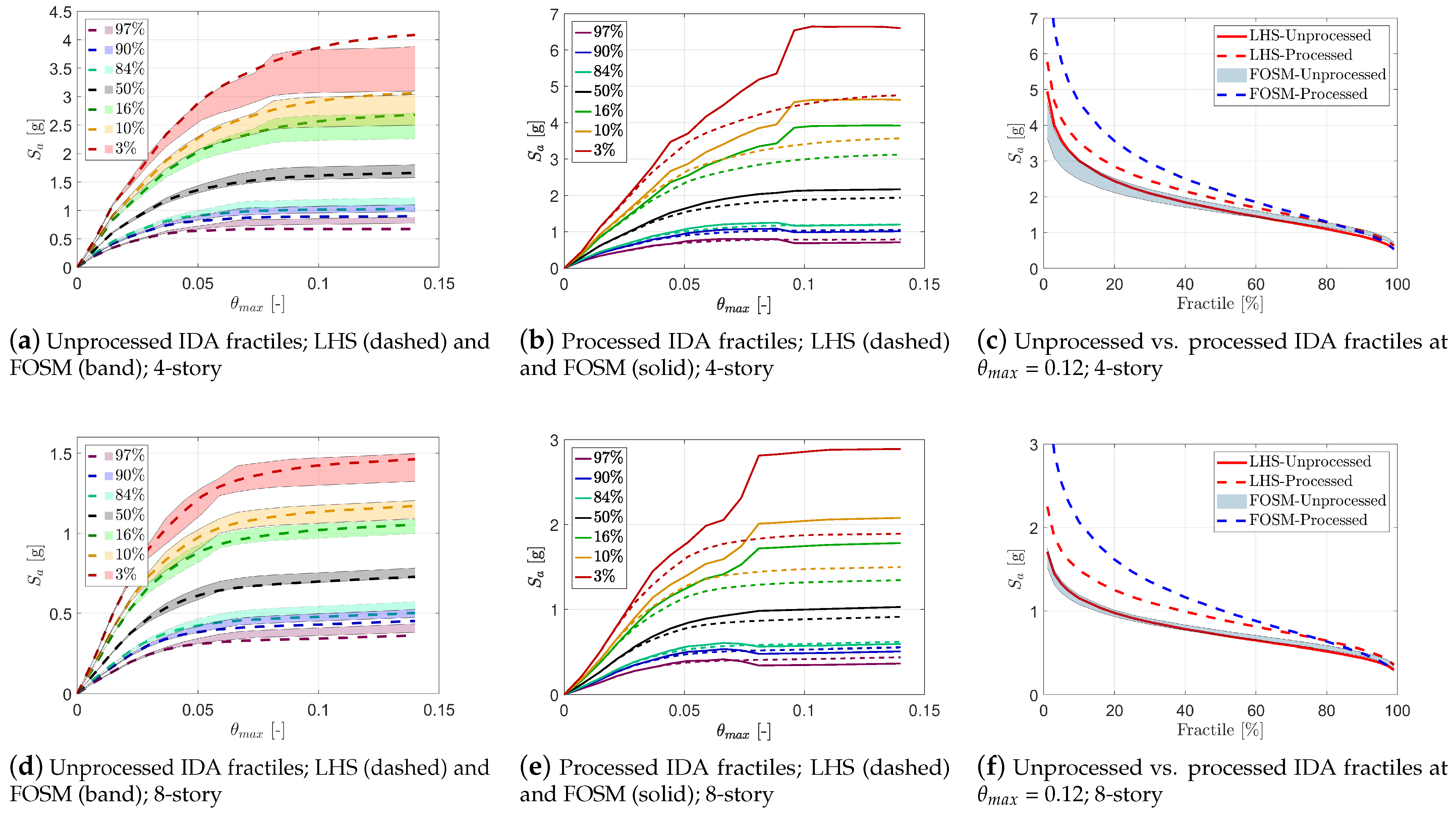
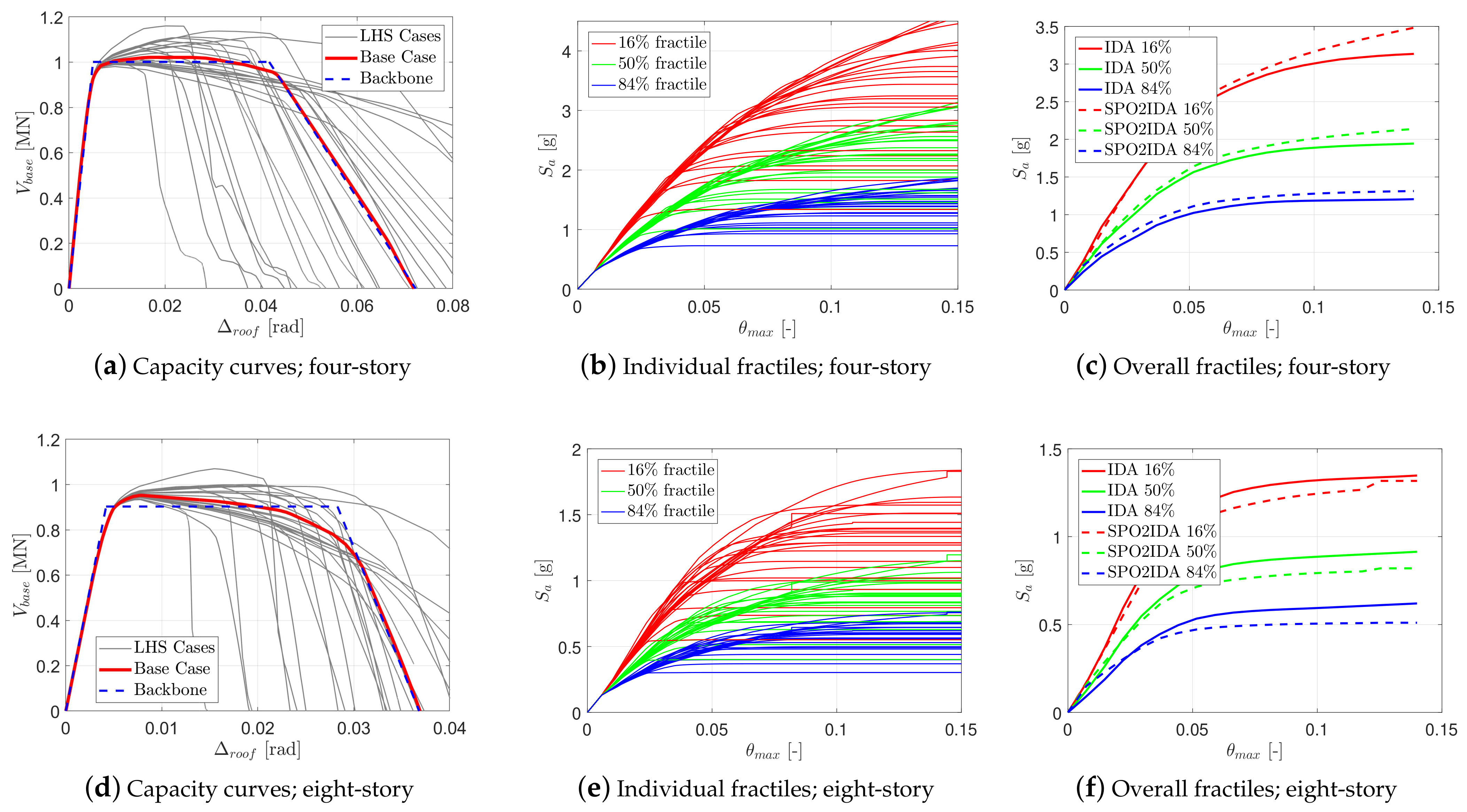
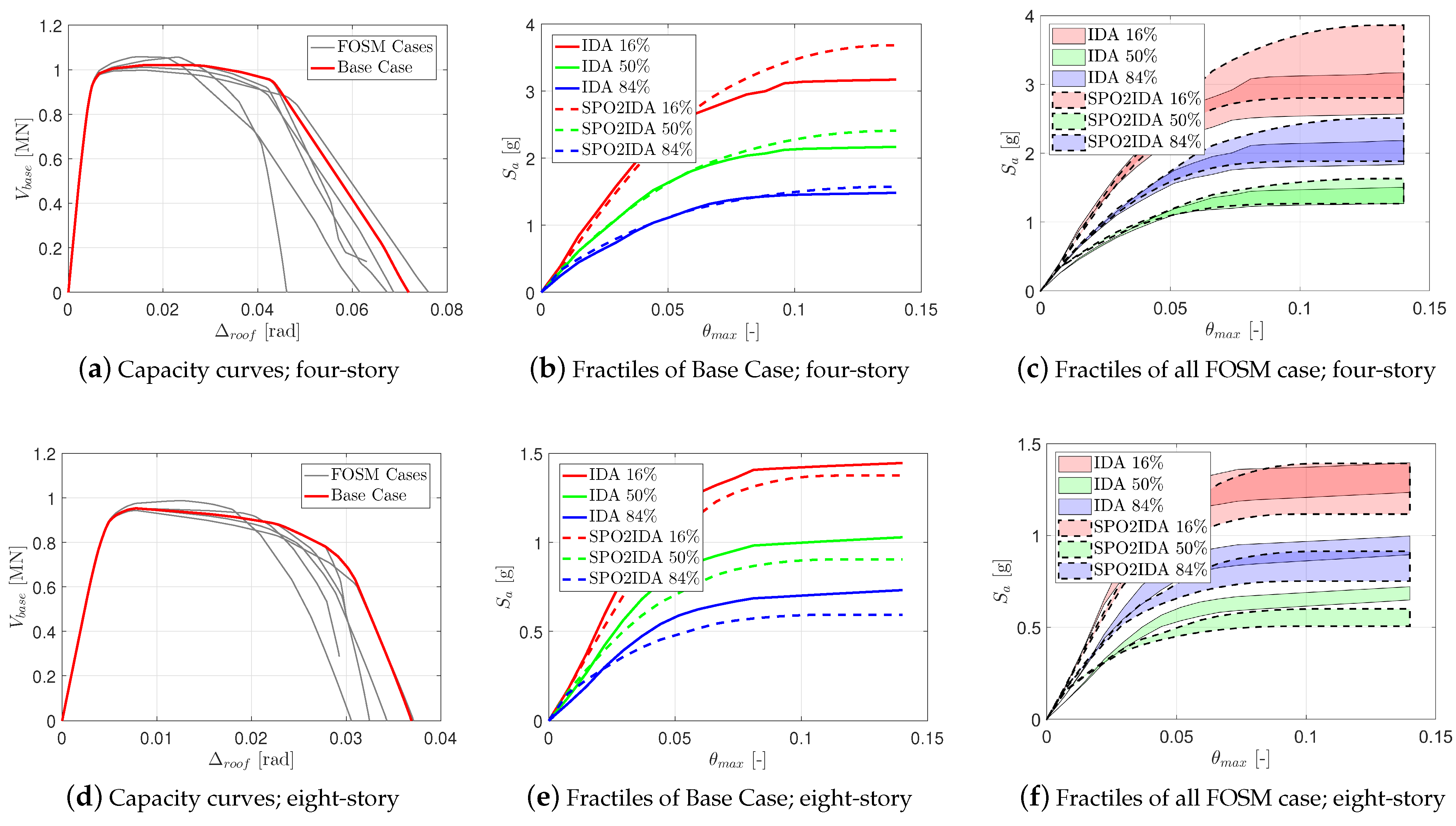
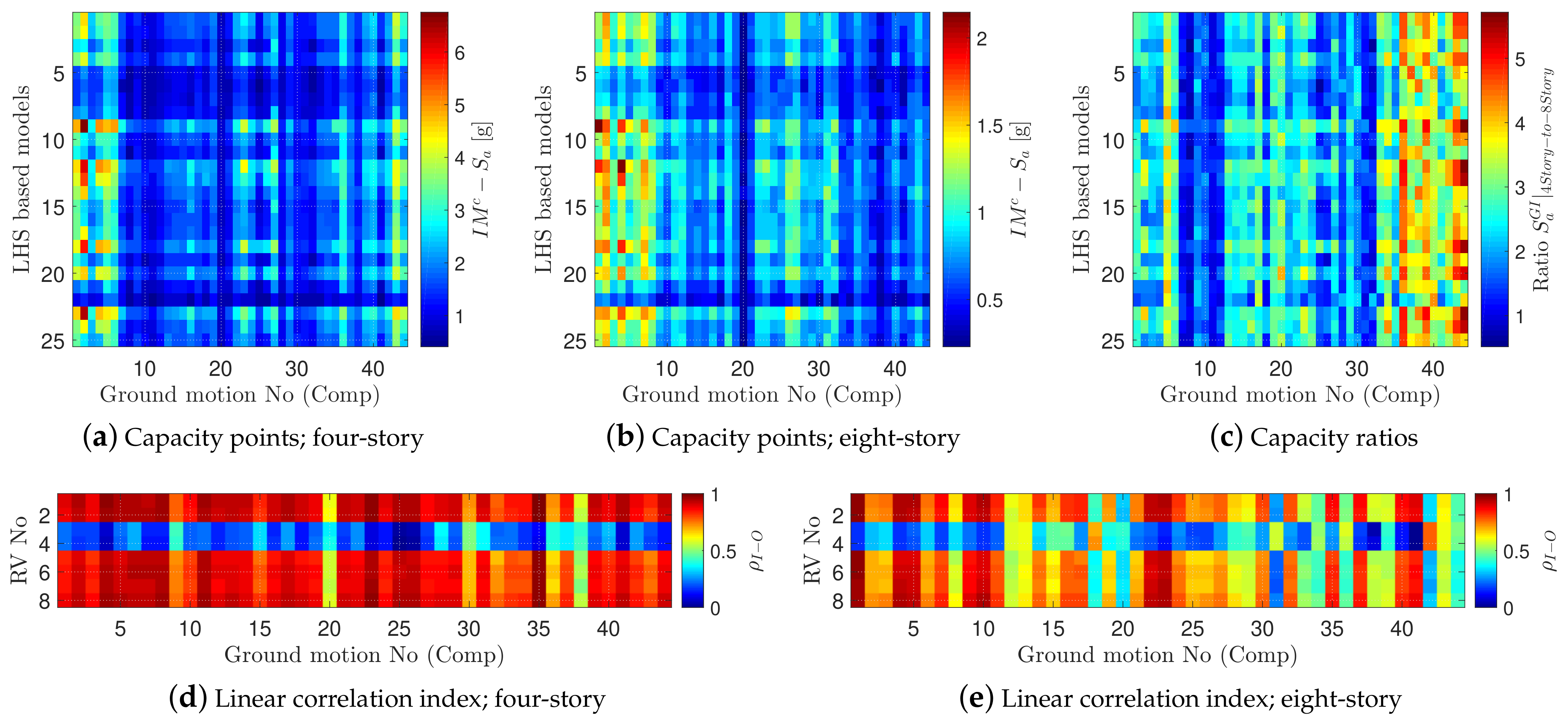
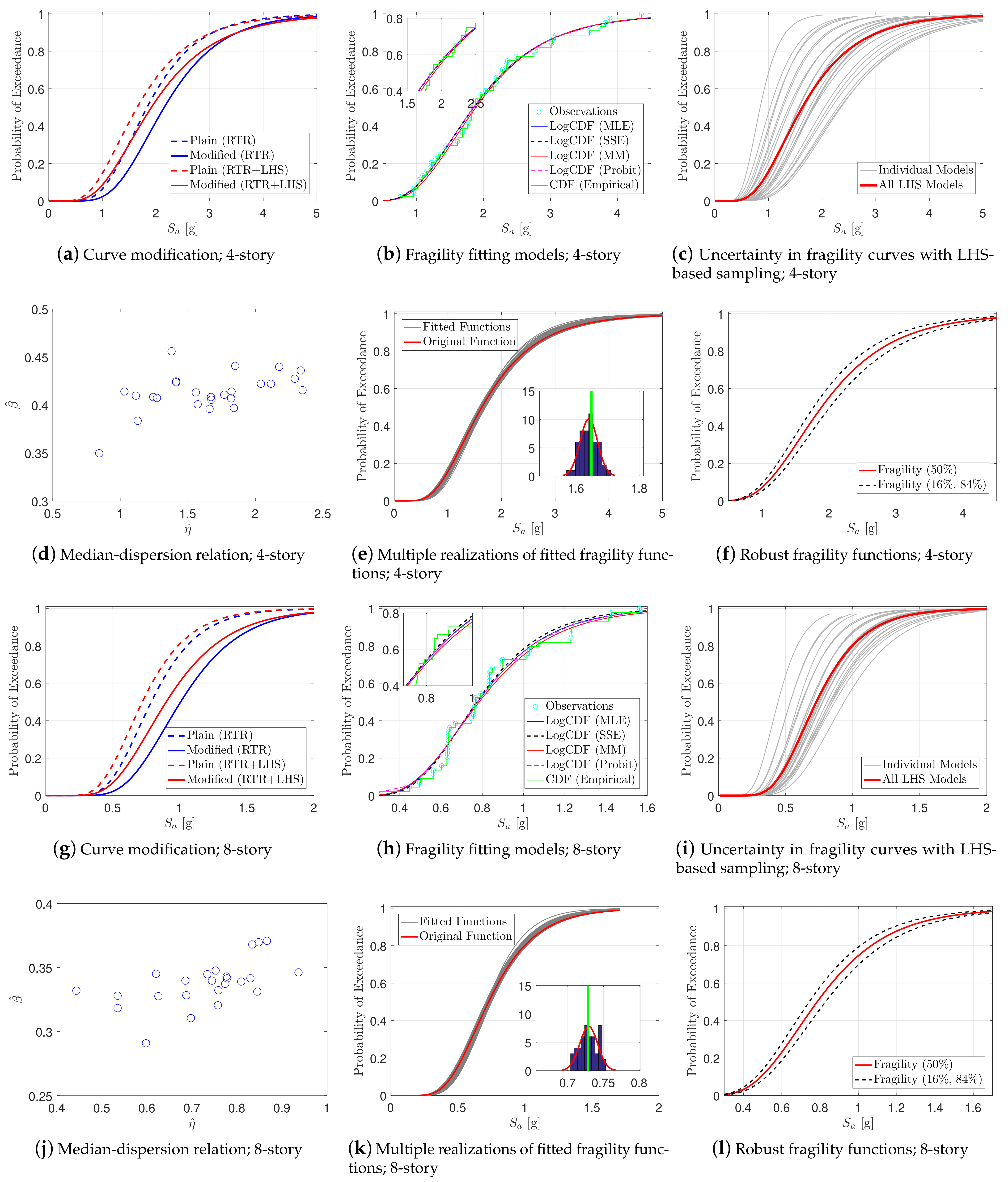

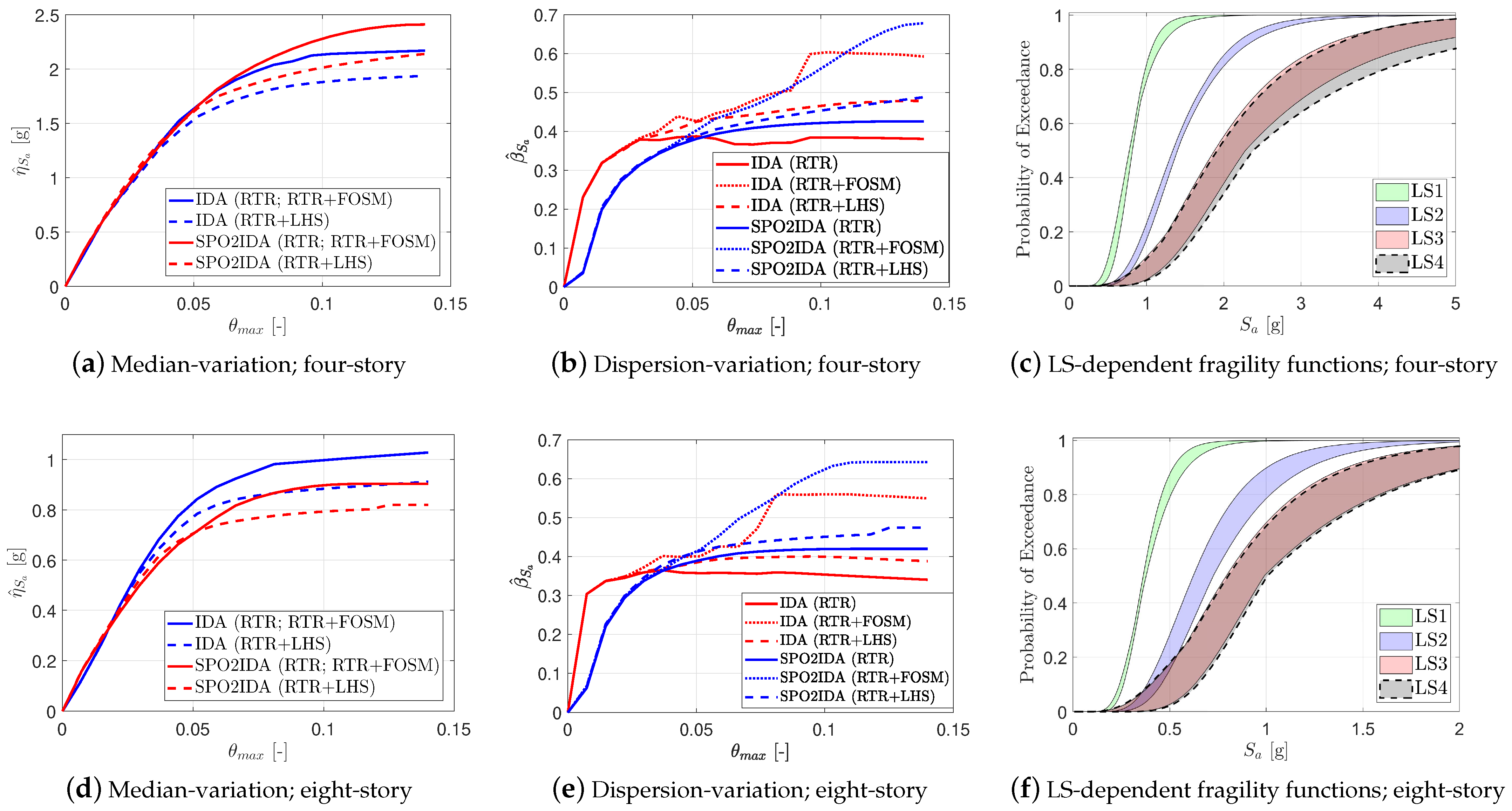
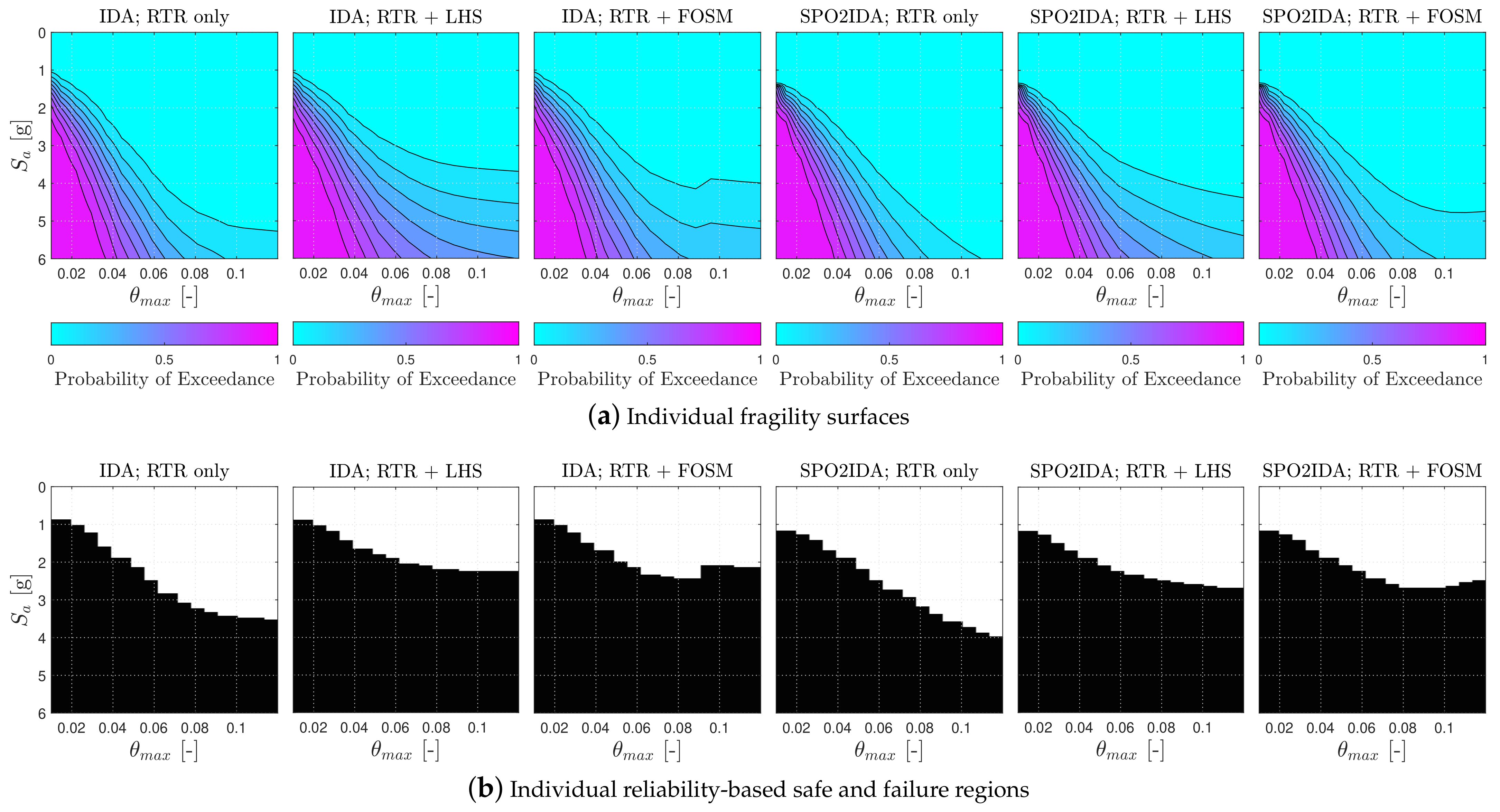
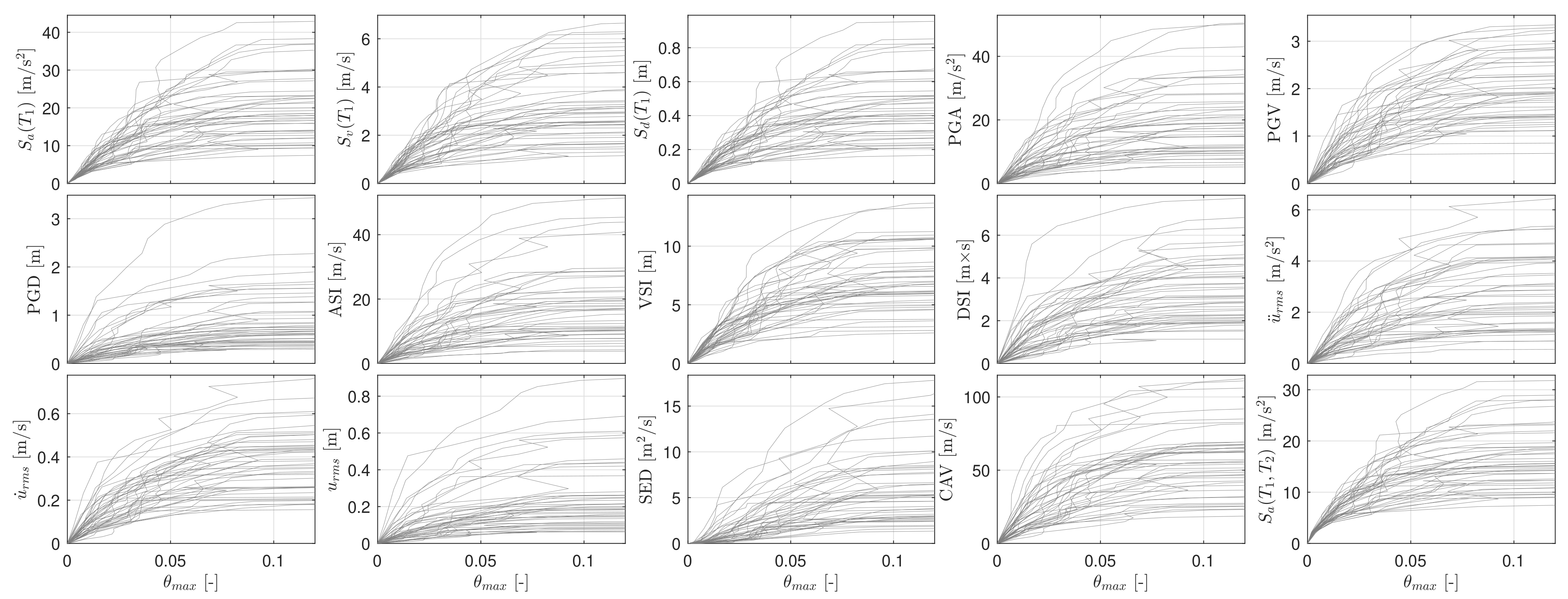
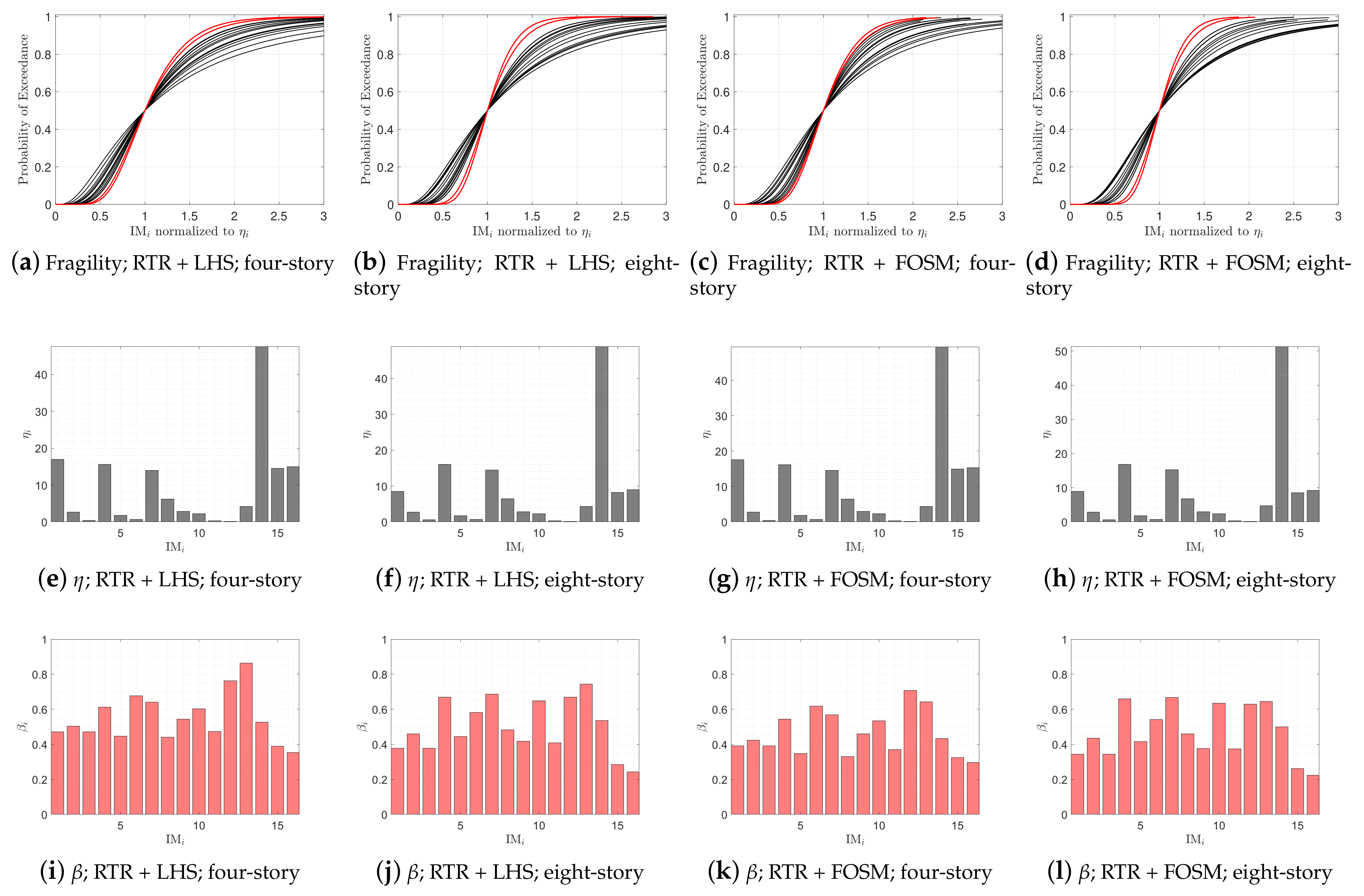
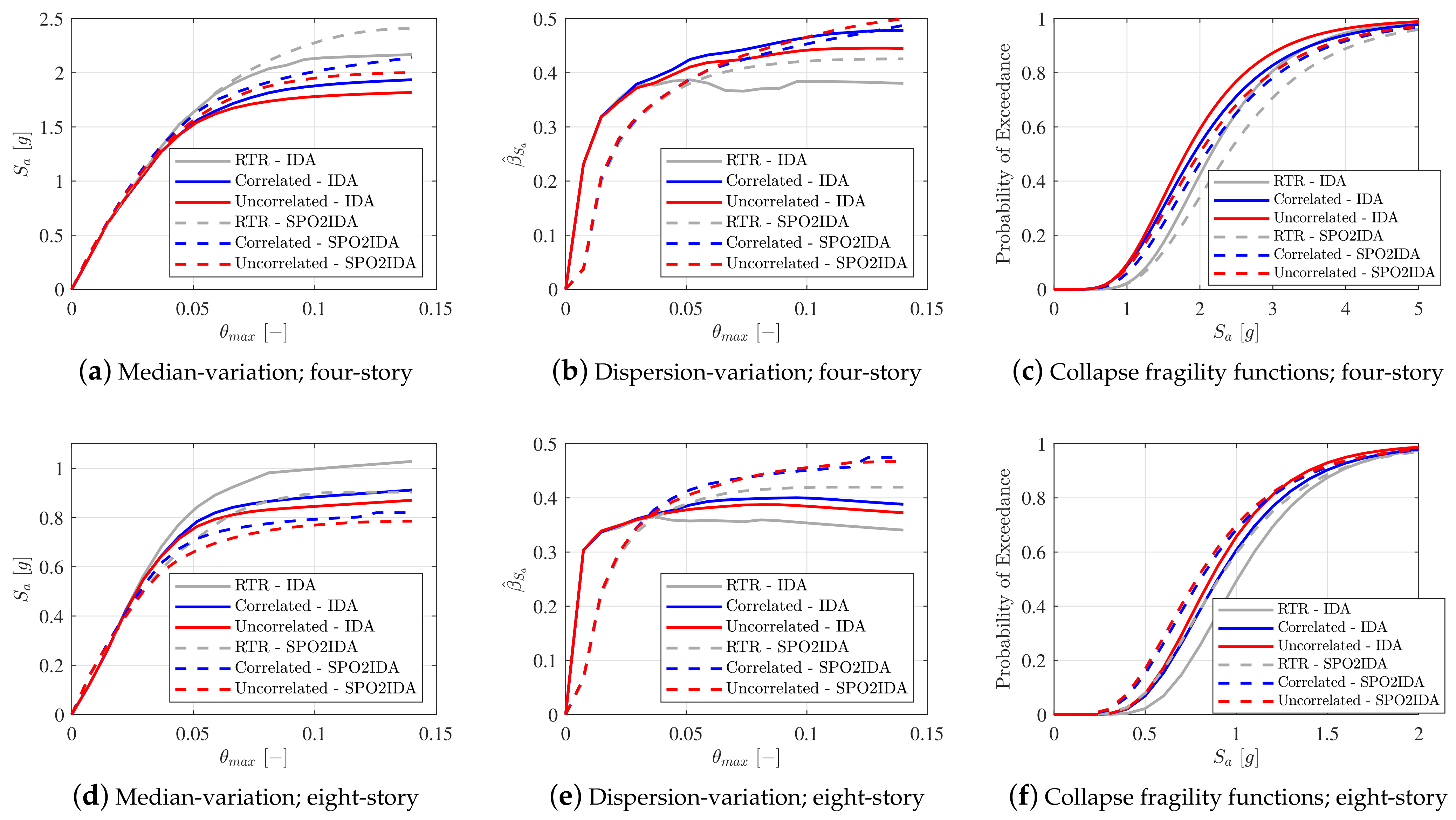
| Simulation Strategy | LS1 | LS2 | LS3 | LS4 | LS1 | LS2 | LS3 | LS4 |
| 4S; IDA (RTR) | 0.34 | 0.38 | 0.38 | 0.38 | 1.00 | 1.00 | 1.00 | 1.00 |
| 4S; IDA (RTR+FOSM) | 0.34 | 0.42 | 0.60 | 0.60 | 1.00 | 1.11 | 1.58 | 1.58 |
| 4S; IDA (RTR+LHS) | 0.34 | 0.4 | 0.47 | 0.48 | 1.00 | 1.05 | 1.24 | 1.26 |
| 4S; SPO2IDA (RTR) | 0.25 | 0.35 | 0.42 | 0.42 | 0.74 | 0.92 | 1.11 | 1.11 |
| 4S; SPO2IDA (RTR+FOSM) | 0.25 | 0.36 | 0.56 | 0.64 | 0.74 | 0.95 | 1.47 | 1.68 |
| 4S; SPO2IDA (RTR+LHS) | 0.25 | 0.36 | 0.45 | 0.47 | 0.74 | 0.95 | 1.18 | 1.24 |
| 8S; IDA (RTR) | 0.34 | 0.36 | 0.35 | 0.34 | 1.00 | 1.00 | 1.00 | 1.00 |
| 8S; IDA (RTR+FOSM) | 0.34 | 0.4 | 0.56 | 0.56 | 1.00 | 1.11 | 1.60 | 1.65 |
| 8S; IDA (RTR+LHS) | 0.34 | 0.37 | 0.4 | 0.39 | 1.00 | 1.03 | 1.14 | 1.15 |
| 8S; SPO2IDA (RTR) | 0.27 | 0.37 | 0.42 | 0.42 | 0.79 | 1.03 | 1.20 | 1.24 |
| 8S; SPO2IDA (RTR+FOSM) | 0.28 | 0.38 | 0.62 | 0.64 | 0.82 | 1.06 | 1.77 | 1.88 |
| 8S; SPO2IDA (RTR+LHS) | 0.28 | 0.39 | 0.45 | 0.46 | 0.82 | 1.08 | 1.29 | 1.35 |
Publisher’s Note: MDPI stays neutral with regard to jurisdictional claims in published maps and institutional affiliations. |
© 2022 by the authors. Licensee MDPI, Basel, Switzerland. This article is an open access article distributed under the terms and conditions of the Creative Commons Attribution (CC BY) license (https://creativecommons.org/licenses/by/4.0/).
Share and Cite
Nasrollahzadeh, K.; Hariri-Ardebili, M.A.; Kiani, H.; Mahdavi, G. An Integrated Sensitivity and Uncertainty Quantification of Fragility Functions in RC Frames. Sustainability 2022, 14, 13082. https://doi.org/10.3390/su142013082
Nasrollahzadeh K, Hariri-Ardebili MA, Kiani H, Mahdavi G. An Integrated Sensitivity and Uncertainty Quantification of Fragility Functions in RC Frames. Sustainability. 2022; 14(20):13082. https://doi.org/10.3390/su142013082
Chicago/Turabian StyleNasrollahzadeh, Kourosh, Mohammad Amin Hariri-Ardebili, Houman Kiani, and Golsa Mahdavi. 2022. "An Integrated Sensitivity and Uncertainty Quantification of Fragility Functions in RC Frames" Sustainability 14, no. 20: 13082. https://doi.org/10.3390/su142013082
APA StyleNasrollahzadeh, K., Hariri-Ardebili, M. A., Kiani, H., & Mahdavi, G. (2022). An Integrated Sensitivity and Uncertainty Quantification of Fragility Functions in RC Frames. Sustainability, 14(20), 13082. https://doi.org/10.3390/su142013082








